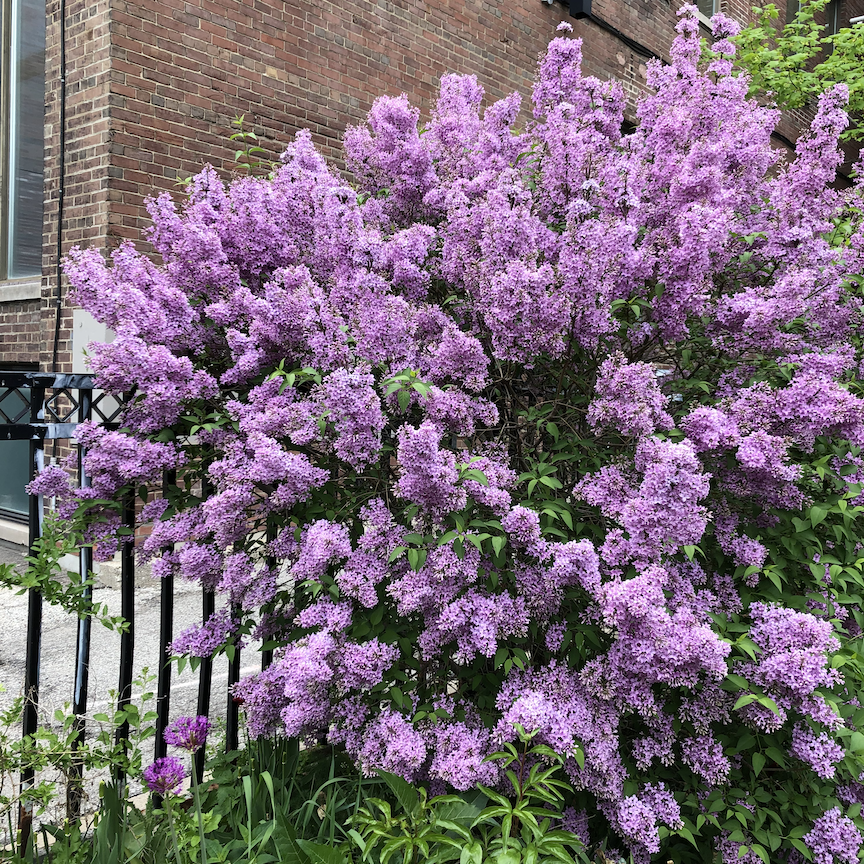Over the past year, I’ve been getting a lot of requests to diagnose and treat poorly performing Lilacs. I thought I’d share a few important care tips to help promote more of these amazingly fragrant blooms in the city.
People who own Lilacs tend to prize this shrub so much that they neglect pruning it, hoping to encourage its growth. But to keep a Lilac dense and flowering, it’s important to prune it every year. Here’s a picture of a Lilac shrub that has been maintained every year. Notice the dense flowers that cover the entire shrub. This is what most Lilac owners have in mind when they let their Lilac grow!
But if the Lilac isn’t maintained regularly, the shrub can stretch and get leggy, which inhibits bloom production. Here’s an example of a Lilac that has been left unpruned too long. Do you notice how its blooms are becoming scarce? Also notice that there is no foliage in the bottom half of the shrub, just stems. This is what we mean when we say the shrub has become “leggy” – it’s all legs, no leaves!
Take a look at the Lilacs in your neighbourhood. Do they look full and healthy to you? Or do you notice they’re slowing down their bloom production?
If you notice they’re getting sparse, here are some tips on Lilac horticultural care specific to our climate in Toronto.
How do I care for a Lilac?
A Lilac doesn’t need much pruning in the first year of ownership. For the first five years, it will focus on establishing roots. Make sure it gets plenty of sun to promote bloom production, and remove spent blooms to keep it tidy. For the first five years, the Lilac will focus on establishing roots, and with enough sun it will not stretch or get leggy.
It’s good practice to start pruning your Lilac at about the 5 year mark. After you have removed the spent blooms, remove any branches that are crossed, growing into each other, damaged, or otherwise looking unhealthy. This can be done safely in the spring or fall (away from the heat of summer and its dormancy in winter).
At about the 10 year mark, it’s good to do a substantial pruning of the oldest ⅓ of growth, which can be cut right to the ground. Removing all that growth usually makes Lilac owners very nervous, but it’s essential to do so in order to promote new growth and to prevent it from getting too woody.
If your Lilac is already overgrown
If your Lilac is already overgrown, some special horticultural care is needed to both protect the plant and to preserve its beauty. You can’t just start removing the oldest branches because it can damage the plant and look too sparse in your garden!
The best way to tend an overgrown Lilac is with a multi-season plan where you slowly prune back the Lilac in stages that the shrub can handle. The first step is to remove any dead branches, which some Lilac owners feel comfortable doing themselves. The next step is to make judicious cuts to the live plant, where we prune back the oldest growth from the edges of the shrub rather than from the ground. This is where having an experienced horticulturalist on hand can be really beneficial. We can identify how much pruning the old-growth shrub can handle, which branches have the best chance for survival, and help you decide which branches can be eliminated while maintaining a lush, full look to the overall shrub.
If you’re interested in preserving or learning to prune your Lilac, please reach out to us. We offer consultations to determine a care plan for your Lilac, and we also offer pruning services to restore and revitalize your Lilac for you. You’re also welcome to join us on a pruning session if you’re interested in learning how to care for your Lilac yourself. Let us know how we can help!



